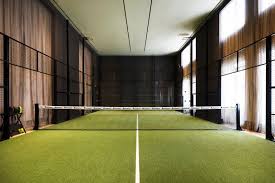

The Fascinating World of Squash Courts
Squash, a fast-paced and exhilarating racquet sport, has garnered a significant following worldwide, thanks in no small part to its unique playing environment—the squash court. These courts are specially designed spaces that not only facilitate the game but also enhance the overall experience for players and spectators alike. In this article, we will explore the key features and dimensions of famous squash courts, their historical significance, and their impact on the sport's development.
The Anatomy of a Squash Court
A standard squash court is rectangular, measuring 32 feet in length and 21 feet in width. The walls, typically constructed from materials like plaster or glass, are crucial components of the game. The front wall is usually the focal point, featuring lines that delineate the service area, the tin at the bottom, and the out-of-bounds area at the top. The bottom edge of the front wall, known as the tin, is crucial; if the ball hits below this line, the shot is considered a fault.
Additionally, the side walls play an equally vital role, as players use them to bounce their shots off when aiming for difficult angles. The back wall often features a glass section, allowing spectators to watch the action from behind, which enhances the atmosphere of the game. Lighting is also a critical aspect of court design to ensure visibility and clarity during play.
Famous squash courts, like the ones seen at major tournaments such as the PSA World Championships or the British Open, are often constructed with glass walls for audience engagement. These courts not only bring the game to life for spectators but also create an immersive environment where players can feel the energy and excitement from the crowd.
Historical Significance

The origins of squash can be traced back to the early 19th century, evolving from a game called “rackets.” The first official squash courts were built in England, and as the sport gained popularity, courts began to emerge in clubs and schools around the world. The sport grew significantly in the 1970s and 1980s, leading to the construction of specialized facilities and notable courts, such as the iconic four-wall courts.
Prominent squash venues, like the more intimate yet exquisite Ashaway Squash and Fitness Club in Rhode Island, USA, or the futuristic glass courts at the Tournament of Champions in New York City, have become symbolic locations in the squash community. These courts have hosted legendary matches and players, contributing to a rich legacy that continues to influence the sport today.
The Impact on Player Performance
The design and quality of squash courts can have a profound impact on player performance and enjoyment. A well-maintained court allows for a fair contest, as the ball behaves predictably when struck against solid, smooth surfaces. Conversely, courts that are poorly maintained can lead to frustrating play and uneven competition.
Moreover, famous courts often have their own stories and personalities. Players have been known to draw inspiration from historic venues, where great champions once played. The atmosphere of a well-known squash court can help invigorate players, making matches not just about physical skill but also about emotional engagement and mental fortitude.
Conclusion
The squash court is more than just a physical space; it is a cornerstone of the sport's identity and culture. From its intricate design to its rich history, the squash court plays a vital role in shaping the experiences of players and fans alike. As squash continues to grow globally, the legacy of these courts will undoubtedly remain a fundamental part of the sport, celebrating both its past achievements and future potential. Whether you are a seasoned player or a newcomer to the game, the allure of the squash court cannot be overstated, embodying the spirit of competition, camaraderie, and sporting excellence.
High-Performance Industrial Flooring Solutions China Paddle Tennis Court for Sale
High-Performance Industrial Flooring Solutions Durable & Cost-Effective
Homogeneous Transparent Floor – Durable & Stylish Rubber Floor Solutions
Premium Homogeneous Transparent Floor for Durable & Stylish Spaces Rubber Floor Solutions
Premium Sports Floor Solutions Durable PVC Sports Floor & Rubber Floor for Gyms
Durable Rubber Composite Floor Premium Rubber Floor & Mats Solutions